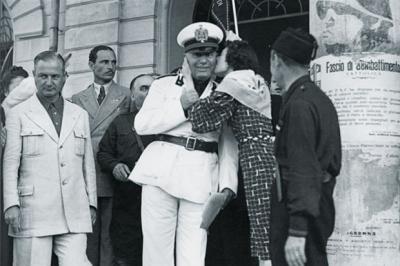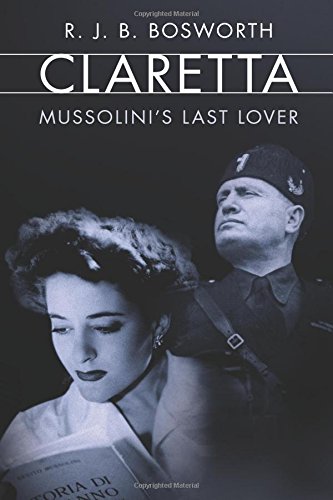Mistress's love for Mussolini explored in new biography

ROME - Newsreels of Hitler’s speeches are frightening, while those of Mussolini, with his jutting jaw and pouting mouth, are simply ridiculous, bringing to mind epithets for him such as the ‘Sawdust Cesar’ and ‘Signor Baloney.’ But Mussolini was a more complex, richer personality than Hitler, according to Richard Bosworth in his study of the dictator’s last lover Claretta, which shows him emotional, complaining of his isolation and even self-questioning.
Bosworth’s thesis is that Mussolini’s relationship with Claretta reveals that the regime never achieved its totalitarian aim to create a new humanity because the familial, the Catholic and much else was fused with Fascism in Italy which, as a result, did not impose its own values as effectively as Nazism or Soviet Communism.
Claretta was the elder daughter of a Roman medical doctor Francesco Saverio Petacci who was physician to a prominent Vatican cardinal as well having a private practice. The head of the family, however, was her devout mother, Giuseppina Persichetti, one of whose relatives was to die as a hero of the anti-Fascist resistance. Claretta had a go-getting elder brother Marcello who was a doctor and a sister Myriam, nine years younger, who had an uneven career as a film star. They were all convinced Fascists before Claretta had a chance meeting with Mussolini when she was 20 and he a married 49 year old with five children. From the age of 14, after an Irishwoman Violet Gibson failed narrowly to assassinate Mussolini, Claretta had been writing him fan letters.
Benito Mussolini had married Rachele, a handsome peasant, but he had affairs mainly with older, sophisticated women who could advance the social and cultural education of a poor, bright and curious Socialist journalist. Rachele was a homebody who did not read books, did not share his wider interests and, he complained, never considered him ‘a great man.’
By the time he met Claretta he referred to lovemaking with his wife as ‘paying taxes.’ At first, Claretta was simply a pretty admirer and, when she declared her love, Mussolini, saying he was old, recommended a strong marriage with her fiancée. Her marriage proved to be brief and unhappy and Claretta became Mussolini’s lover four years after their first meeting.
Mussolini found himself married to her whole family as well as Claretta. And family was stronger than Fascism. Claretta made it clear early on that he was expected to benefit her family in multiple ways from promoting careers and opportunities for gain to easing the Petaccis through bureaucratic difficulties, and he did so. He obtained an assurance from her complaisant mother that Claretta did not have other lovers.
With one cruel exception Mussolini, who had nine illegitimate children from eight women, recognized his responsibilities and gave lifelong aid to these sub-families. He talked about the ‘infinite joy’ of fatherhood. He impregnated Claretta but she had a miscarriage and it seems that subsequently she could not have children. Nevertheless their relationship was lengthy and intense: sometimes Mussolini rang her twenty times a day. They exchanged numerous long letters and she kept a diary assiduously.
There was a dramatic change in June 1943 when Mussolini was voted out by what previously had been a token body, the Council of Fascism, arrested and imprisoned. He was rescued by the Germans who set him up as head of a puppet state in northern Italy which led to a civil war causing more deaths and destruction than before Italy switched to the Allied side.
While Mussolini was in prison, Claretta and her sister were also imprisoned and Romans who hated the social- climbing family wrecked their huge villa while leaving Mussolini’s intact. The Petaccis followed Mussolini north, living near his new residence at Salò on Lake Garda where he had his family and as many as 200 hangers-on. Claretta managed only rare brief meetings with him. Mussolini was ill and depressed ( ‘I’m an utterly ridiculous person… ‘surrounded by bastards and idiots’) whereas Claretta was increasingly resolute and insistent that he be harsher to his opponents, especially Jews. She feared that Rachele and the Fascists around Mussolini planned to kill or kidnap her while Rachele feared that Claretta aimed to replace her. Rachele went after Claretta with a pistol but, rather than use it, merely abused her as a ‘whore’. It was melodrama swinging between imminent tragedy and comic opera.
Mussolini tried to appease the two jealous women but Myriam, now 21, whom he had called playfully ‘la piccola idiota’ when she was an adolescent chaperone for his meetings with Claretta, wrote letters dressing him down. She repeated her sister’s accusations of cowardice, adding Claretta ‘ is always right.’ Their mother also wrote to him. The Petaccis became an annoying distraction from Mussolini’s main business of unwittingly wrecking Italy.
Eventually, as Allied forces drew near, the Petacci and Mussolini families found refuge further north, leaving Mussolini and Claretta by the lake but then he left for Milan making no provision for her safety. From Milan he fled north in a convoy which was intercepted by Partisans who also stopped an Alfa Romeo driven by Marcello Petacci, carrying his own family and Claretta. She asked the Partisans to kill her with Mussolini because her ‘life would have no sense once he was dead.’
Both were shot and their bullet-ridden corpses, with others, were taken to Milan, savaged by a vengeful crowd and hanged up upside down at a petrol station.
It is a gruesome story. Sydney University graduate Richard Bosworth, a senior research fellow in history at Jesus College, Oxford and author of many books on modern Italian history, is the first English-language historian who has made use of the copious documentation Claretta left in diaries and in the letters between her and ‘Ben’. They were taken by the State Archives so there is no problem about their authenticity as there is about alleged Mussolini diaries.
They record that Mussolini was a violent lover but Claretta was satisfied that a great man meant great sex. He primed her with reminiscences of previous conquests and she rose to the competitive challenge. However although publicity promises ‘graphically detailed accounts of sexual life’ there are few details or descriptions as Claretta’s prose was prim, for instance coyly using only the first letter of the words when referring to prostitutes or bums.
A meticulous researcher, Bosworth tells the story judiciously and vividly in the context of Mussolini’s relations with all his lovers and true to historians’ current interest in their subjects’ private lives, emotions and psychology. But although Mussolini devoted a lot of time to women, they do not seem to have influenced his major decisions, for instance that as late as 1940 to throw in his lot irrevocably with Hitler. The book provides insight into the corruption of the regime but also, intentionally or not, inspires pity for the two wrongheaded lovers. Although Mussolini was bombastic in public he could be shrewd in private and, in his last years, recognised his crushing political and personal failures. Bosworth is cool towards Claretta, perhaps to counter latter-day admirers who see her as a sensual saint, but I think she deserves credit for her courage in choosing to die with Mussolini.
Claretta: Mussolini’s Last Lover
R.J.B Bosworth
Yale University Press
312 pages. £ 18.99 in UK



